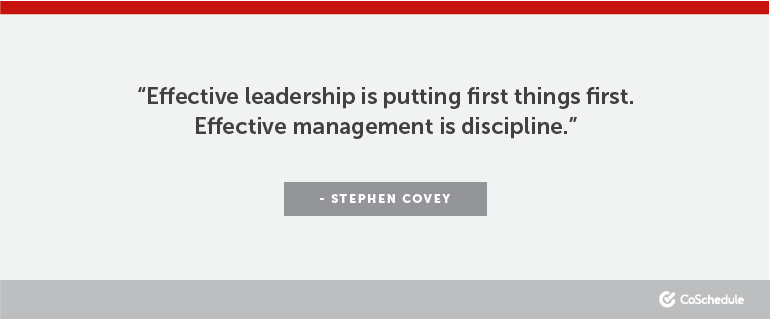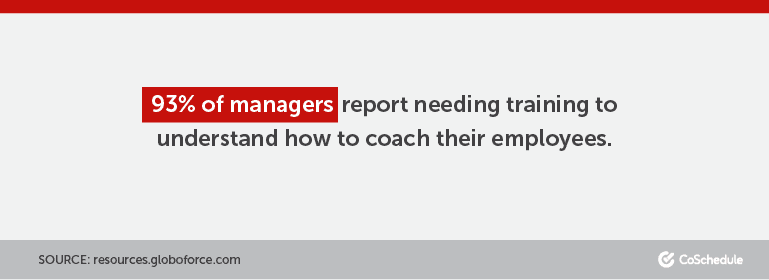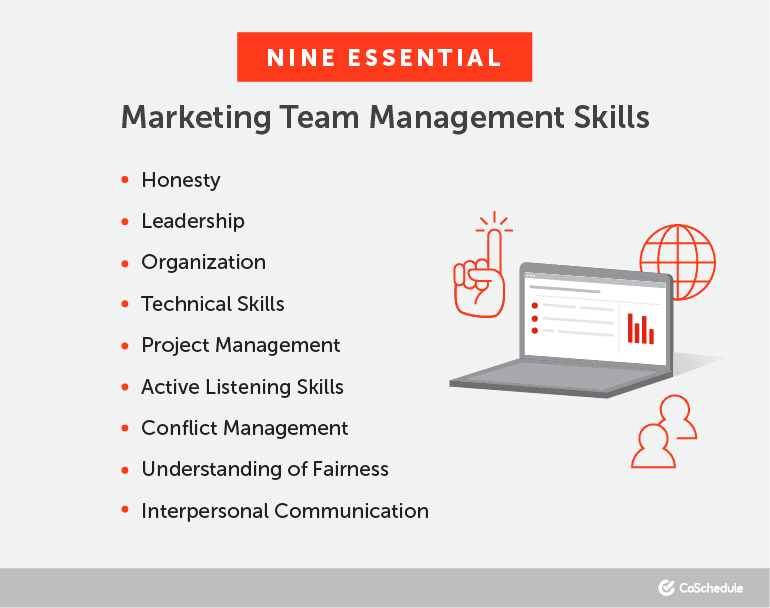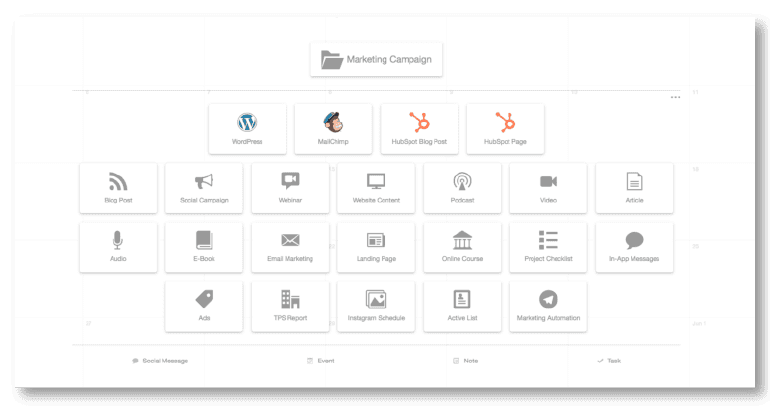How to Stop Fire Drills and Make Effective Marketing Team Management Easy
 Managing a team can feel like the weight of the world is on your shoulders.
You’re responsible not only for your own work, but for the output of all your direct reports, too.
In fact, it has been said that the true measure of a manager’s productivity, is actually the measure of their team’s output as a whole.
No pressure, right?
Fortunately, learning how to effectively guide high-functioning marketing departments isn’t impossible.
By investing in proper skill development and establishing solid processes, you can stop feeling like you’re herding cats and successfully lead your team to success.
Managing a team can feel like the weight of the world is on your shoulders.
You’re responsible not only for your own work, but for the output of all your direct reports, too.
In fact, it has been said that the true measure of a manager’s productivity, is actually the measure of their team’s output as a whole.
No pressure, right?
Fortunately, learning how to effectively guide high-functioning marketing departments isn’t impossible.
By investing in proper skill development and establishing solid processes, you can stop feeling like you’re herding cats and successfully lead your team to success.
Free templates to help you effectively manage your marketing team.
Click To TweetFirst, Snag Some Free Templates
Before digging into the meat of this post, take a second to download these no-cost resources:- Marketing Project Management Calendar Template (Excel): See everything your team is working on.
- Marketing Workflow Checklist Template (Excel): Help each team member execute projects correctly with clear checklists.
- Marketing Project Management Plan (Word): Map out a strategy for managing your team’s projects.
What is the Real Role of a Team Manager?
Managing people is about much more than just being someone else’s boss. It means making your success be other’s success. Everything else about the role stems from this simple truth. When you’re in the lead, it isn’t all about you, even though you’re ultimately the one steering the ship. It’s about making sure everyone performs up to their potential. Achieving that aim is easier said than done though.
Effective leadership is putting first things first. Effective management is discipline.
Click To TweetIntroducing the Team Management Dashboard in CoSchedule
One way to give yourself the edge when it comes to team management is to use the Team Management Dashboard in CoSchedule (and if you’re new, it’s an industry-leading marketing management platform). It makes it easy to see your entire team’s workload and the progress they’re making in one place:
What Are Some Common Team Management Roadblocks?
Whether you’re new to management or you’ve been leading marketing teams for a while, you’re bound to face some barriers.Barrier #1: Siloed Teams
The team you’re managing will likely need to collaborate with other teams, too. But, if those teams are siloed, that can make getting things done difficult. There are a few reasons for that:- You can’t move faster than the other team is willing to go. They likely have other projects and their own priorities, beyond just the things you’re collaborating on.
- Getting teams on the same page can be tough. For the reasons listed above.
- Different processes can clash. They have their way of doing things, and you’ve got yours. If the two can’t be reconciled, work starts to break down.
Barrier #2: Lack of Clear, Shared Goals
Rallying your team to succeed requires having a shared goal. Otherwise, what are you actually working toward? Without some sort of objective, you’re liable to just do a lot of stuff, look busy, and accomplish nothing. That, in turn, leads to a burned out team that’s working hard but ends up with nothing to show for it.
Rallying your team to succeed requires having a shared goal. Otherwise, what are you working toward?
Click To TweetBarrier #3: Lack of Leadership
If no one’s steering the ship, you’ll never end up where you want to go. And if you’re reading this, odds are leadership falls on your shoulders. Businesses, in general, are feeling a gap between leadership wants and reality, too. According to a study from Globoforce, a full 93% of managers need training on how to train their teams. If that sounds shocking, perhaps it shouldn’t. Management and leadership are skills that take years of experience to develop. Excelling at helping others excel takes years of intentional practice. Fortunately, you don’t have to depend completely on hard-fought lessons in the rough and tumble trenches of marketing and business. For one thing, you’re reading this blog post. That’s a point in your favor. And if you’re part of the 93% who need some help, at least you’re not alone (and odds are the other 7% are lying anyway).
93% of managers report that they need training to understand how to coach their employees.
Click To TweetBarrier #4: Disorganization
When people and processes are disorganized, everything else downstream has a tendency to fall apart. How damaging is disorganization when it comes to collaboration and productivity? Damaging enough for The Wall Street Journal to cover it. Sure, it’s an older piece about being messy in your personal life, but the principles still apply. Business2Community calls out some more workplace-specific downsides to disorganization:- Time wasted looking for things. Can’t find your files? Or that important memo in your inbox? Time spent searching is time spent not getting things done.
- Opportunities get missed. Because you couldn’t find that one email or forgot to follow up on something.
- Increased stress. And added stress leads to added problems elsewhere.
- Decreased morale. Once morale starts to drop, you can expect employee turnover to go up.
- Losing money. Stemming from the previous four problems compounding one another.
Barrier #5: Egos
Unchecked egos and selfish behavior can completely undermine a team’s success, and make managing one much more difficult. The fact is that teams win and lose as a group. One person thinking they know better than anyone else can throw everyone’s efforts off track, and generally create an environment where no one wants to work. This problem is pervasive enough that authors David Marcum and Steven Smith wrote in the book Egonomics that ego is “the invisible line item on every company’s profit and loss statement.”Nine Essential Team Management Skills to Master
Avoiding the pitfalls outlined above and guiding your team toward success will require a robust skill set. Here are nine must-haves:- Leadership: Yes, it’s a skill you can build. Everything else starts here.
- Organization: Getting your team organized starts with getting yourself organized first.
- Technical Skills and Understanding: Even if you don’t actually know how to execute the work of the team you’re managing, at the very least you need to speak their lingo and understand it from a conceptual and theoretical perspective.
- Interpersonal Communication: You don’t have to be a fantastic people-person. You just need some self-awareness, emotional intelligence, and a basic ability to communicate and relate to your team members.
- Project Management: Part of managing teams is managing their work, ensuring projects move smoothly from start to finish, toward a shared goal.
- Conflict Management: When disputes arise, you need to put out the fire.
- Active Listening Skills: Understanding your team’s needs starts with the ability to clearly interpret and know what they’re trying to tell you.
- Honesty: Burying bad news and failing to deliver frank feedback leads to a lack of transparency and skill development, both of which are corrosive to team functioning.
- Understanding of Fairness: Playing favorites is a fast way to lose favor with the rest of your department.
 Next, here are some additional tips and resources on how to develop each of these skills to make you an effective team manager.
Next, here are some additional tips and resources on how to develop each of these skills to make you an effective team manager.
Leadership
CoSchedule has a number of team leads who didn’t have team management experience prior to joining the company. How did they learn? A few ways:- Mentorship: If you don’t have a mentor, get one. Even leaders need guidance.
- Reading: Old-fashioned book learning can go a long way.
- Experience: The lessons you learn the hard way are sometimes the ones that stick the most.
- Get some books, right now: Here are the top-selling leadership books on Amazon.
- Sign up for some webinars: The Center for Creative Leadership and Ken Blanchard’s training webinars are two good places to start.
- Be a mentor to your team: Taking the time to learn your team member’s individual goals and helping them achieve those goals, as simple as that sounds, will help you develop your own knowledge and skills, too.
Organization
Managing marketing teams is often akin to herding cats. That is, at least, if you don’t invest time or resources in getting organized. Sometimes, marketers and creative professionals take pride in being productive without being organized. But, that attitude almost assuredly holds teams back. This can be as simple as nailing down the following two things:- Have a process for every project. Following the same steps each time builds routines that ensure things get done right the first time, every time, without missed steps.
- Get tools to get organized. But remember you need the first part above before this part will matter.
Technical Skills and Development
Even if you’ve moved into a leadership role, there’s still value in keeping your execution skills sharp. It’s also worth developing knowledge around what all your team members do. Fortunately, there are more resources available than ever to continue your learning and professional development online.- Follow blogs that cover all different areas your team is responsible for (even things you don’t have first-hand experience executing yourself). This will help you set realistic expectations for your team and actually understand what they do.
- Consider joining the CoSchedule Academy. It’s packed full of actionable lessons on all sorts of different areas and disciplines of marketing.
Project Management
At a basic level, team leads are often responsible for managing projects. You might not consider yourself a project manager by trade (which is a broad and complex discipline), but you do need to coordinate projects and campaigns to make sure they’re executed efficiently and effectively.- Get agile. If you’re not familiar with agile marketing, Roland Smart’s The Agile Marketer is a great place to start.
- Take courses. Like this one from Udemy.
- Consider certification. If you want to kick things up another level, the Project Management Institute offers several levels of certification.
Conflict Management
It’s common for people to butt heads in the workplace. But when things spiral out of control, it’s up to you to resolve the issue. This isn’t typically easy or comfortable. Neither of those facts are excuses, though. So, what do you do? The American Management Association outlines a five-step process:- Get to the root of the problem.
- Investigate whether the conflict stems from a deeper problem.
- Ask those involved to offer solutions, rather than just complain.
- Narrow those solutions down to options both sides can support.
- Agree to a resolution.
Active Listening Skills
Active listening means more than just hearing what people say. You have to also understand the actual meaning of what people are trying to tell you. This is especially important for managing teams, particularly if you have team members who are reticent to explain concerns in clear language. Developing better listening skills isn’t hard though. It just requires some intentional thought and practice.Honesty
The word “authenticity” has gotten carelessly batted around the marketing industry so much that the word has almost lost its meaning. However, being authentic with your communication is crucial for managing teams effectively. This goes for everyone else in just about any company or organization, too. Lack of honest communication can cause a lot of other problems that become compounded over time.- Encourage a culture of honest communication. People should be respectful, but it should also be made clear that it’s important to say what you really mean.
- Avoid reprimanding people just for giving you honest feedback. Managers make mistakes. No one’s perfect. But, when your team lets you know when and where you’ve fallen short, endeavor to take that feedback to heart and improve, rather than going on the defensive.
- Let your team know you’re on their side. If they know you’re cheering for their success, they’ll take criticism much more constructively than if they feel they’re being attacked.
Understanding of Fairness
Don’t play favorites between team members. That’s all there is to say here.A Simple Framework For Leading Your Team
So, how do you actually apply all of this information? Starting with a clear management framework is a good place to start. Here’s an adapted version of how CoSchedule manages its teams.Schedule Daily Scrum Meetings
The “scrum” concept comes from the agile software development world, but it has become increasingly common in marketing teams, too. In plain English, they’re daily meetings where everyone on the team talks about:- What they did yesterday.
- What they’re doing today.
- What might prevent them from finishing their work.

Schedule Weekly One-on-One Meetings
In addition to daily scrums, set up one-on-one syncs with each team member. Set aside a half-hour to an hour at the same day and time each week. In those meetings, pull open a Google Doc or Evernote and take notes on the following:- What’s going well right now?
- What issues need to be solved?
- What ideas do you have for future improvement?
Plan All Your Projects in One Place
Where do all those projects live? Ideally, in some type of marketing management platform. CoSchedule is the perfect option for the job, too. It’s a software management platform that’s built to be the hub for all your projects, team members, and tools. Here’s a quick look at how it works: This will present you with all of the different content types you’ve specified for your calendar (these can be customized easily to fit your needs):
This will present you with all of the different content types you’ve specified for your calendar (these can be customized easily to fit your needs):
 For the sake of example, let’s start with a WordPress post. Give it a title:
For the sake of example, let’s start with a WordPress post. Give it a title:
 Next, over to the right, you’ll add Team Members and Tasks.
Next, over to the right, you’ll add Team Members and Tasks.
Develop Clear Workflows for Recurring Projects
Once your team is in CoSchedule, use Tasks to create a checklist for the project workflow (or use Task Templates to create and save reusable task lists). Clicking the face silhouettes will allow you to assign any users associated with your account, to the project: Click into the “New task …” box, assign it to a team member, and add a deadline:
Click into the “New task …” box, assign it to a team member, and add a deadline:
 Continue until you’ve created an entire workflow. Then, as you’re working through the project, use Discussion Threads to communicate with the team, share files, and manage version control on documents:
Continue until you’ve created an entire workflow. Then, as you’re working through the project, use Discussion Threads to communicate with the team, share files, and manage version control on documents:
 Once the project is created, you’ll be able to see it alongside all your other campaigns and projects, all in one place, too:
Once the project is created, you’ll be able to see it alongside all your other campaigns and projects, all in one place, too:

Measure the Team’s Output
Finally, once you have your team management process in place, you’ll want to measure the results. The easiest way to do this is with Team Performance Reports in CoSchedule. Find your Analytics tab here: Then click Team Performance Report:
Then click Team Performance Report:
 Next, you’ll see comprehensive charts breaking down the percentage of tasks each team member has completed on time and passed deadline. Each time someone checks off a task on a project, it’s tabulated here.
You can see this across your entire team or company:
Next, you’ll see comprehensive charts breaking down the percentage of tasks each team member has completed on time and passed deadline. Each time someone checks off a task on a project, it’s tabulated here.
You can see this across your entire team or company:
 And by team member:
And by team member:
 This makes it easy to see exactly how well the team is hitting its deadlines, and whether there may be productivity hurdles to overcome. It’s possible that some team members might be overloaded, while others may need more challenges.
This makes it easy to see exactly how well the team is hitting its deadlines, and whether there may be productivity hurdles to overcome. It’s possible that some team members might be overloaded, while others may need more challenges.



